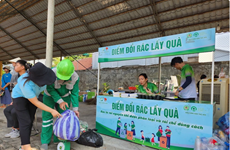Vietnam strives to reduce CO2
From improving institutions to devising detailed plans for each sector,
Vietnam is making every effort in order to dramatically reduce CO2
emissions by 2030.
From improving institutions to devising detailed plans for each sector,
Vietnam is making every effort in order to dramatically reduce CO2
emissions by 2030.
Vietnam is predicted to pump 466 million tonnes of CO2 into the air by 2020 and 760.5 million tonnes by 2030. The energy sector will account for the lion’s share, with 381.1 million tonnes by 2020 and 648.5 million tonnes by 2030.
Huynh Thi Lan Huong from the Vietnam Institute of Meteorology , Hydrology and Environment (IMHEN) said the institutions required to implement the “Nationally Appropriate Mitigation Action’ (NAMA) in Vietnam are being built while a number of technical assistance activities have begun, including the building of scenarios for CO2 reduction.
She noted however, that the capacity of ministries and related agencies in building NAMA projects as well as supervising and assessing the efforts to reduce CO2 emissions is still limited.
NAMA projects in the energy, industry, construction, agriculture, forestry, and waste management sectors have been designed but not funded.
Over the past few years, the Ministry of Natural Resources and Environment (MoNRE), in collaboration with relevant agencies, has implemented a project on facilitating implementation and readiness for mitigation of emission (FIRM) funded by the Danish International Development Agency.
The project is designed to assist efforts to reduce green house gas emissions, contributing to Vietnam’s green and low-carbon trend.
The project also helped remove non-financial barriers to building and piloting prioritised NAMA projects, including the Assistance for Wind Power Development project and the Electricity Generation from Biogas at medium-and-large-size pig farms project.
The General Department of Energy under the Ministry of Industry and Trade has also prepared the “Fund for Renewable Energy Development-Mechanism GET FiT Vietnam” project to submit to NAMA Facility for review and assistance.
Nguyen Minh Bao from the Energy Institute under the Ministry of Industry and Trade said Vietnam had 253 clean development mechanism (CDM) projects as of June 2014, potentially eliminating the expulsion of 137 million tonnes of CO2, as well as 11 CDM-registered programmes and 10,068,987 certified emission reduction (CER) certificates.
The country is ranked fourth globally in the number of registered CDM projects and 11th in the number of granted CER certificates.
Vietnam has also cooperated with Japan in the field under their Memorandum on Cooperation in low-carbon growth signed in July 2013. The MoNRE was assigned to coordinate with Japan to establish the Committee on the Joint Crediting Mechanism (JCM).
Japan has proposed 28 JCM projects, 18 of which are in the energy sector, four in transport, four in waste management and three in forestry, with a combined potential reduction of 10 million tonnes of CO2 annually.
Vietnam has also prepared detailed plans for reducing CO2 emissions in each economic sector.
The energy sector has six plans built on the “Business As Usual” scenario, based on the assumption that new policies will be enacted to support technological development reducing CO2 emissions, such as energy-saving and renewable energy technologies.
The total potential CO2 reduction in the energy sector is 237.3 million tonnes.
In agriculture, two plans will be implemented which aim to reduce 10.8 million tonnes of CO2 by 2030.
There are three plans to reduce CO2 emissions in forestry by up to 792 million tonnes.-VNA
Vietnam is predicted to pump 466 million tonnes of CO2 into the air by 2020 and 760.5 million tonnes by 2030. The energy sector will account for the lion’s share, with 381.1 million tonnes by 2020 and 648.5 million tonnes by 2030.
Huynh Thi Lan Huong from the Vietnam Institute of Meteorology , Hydrology and Environment (IMHEN) said the institutions required to implement the “Nationally Appropriate Mitigation Action’ (NAMA) in Vietnam are being built while a number of technical assistance activities have begun, including the building of scenarios for CO2 reduction.
She noted however, that the capacity of ministries and related agencies in building NAMA projects as well as supervising and assessing the efforts to reduce CO2 emissions is still limited.
NAMA projects in the energy, industry, construction, agriculture, forestry, and waste management sectors have been designed but not funded.
Over the past few years, the Ministry of Natural Resources and Environment (MoNRE), in collaboration with relevant agencies, has implemented a project on facilitating implementation and readiness for mitigation of emission (FIRM) funded by the Danish International Development Agency.
The project is designed to assist efforts to reduce green house gas emissions, contributing to Vietnam’s green and low-carbon trend.
The project also helped remove non-financial barriers to building and piloting prioritised NAMA projects, including the Assistance for Wind Power Development project and the Electricity Generation from Biogas at medium-and-large-size pig farms project.
The General Department of Energy under the Ministry of Industry and Trade has also prepared the “Fund for Renewable Energy Development-Mechanism GET FiT Vietnam” project to submit to NAMA Facility for review and assistance.
Nguyen Minh Bao from the Energy Institute under the Ministry of Industry and Trade said Vietnam had 253 clean development mechanism (CDM) projects as of June 2014, potentially eliminating the expulsion of 137 million tonnes of CO2, as well as 11 CDM-registered programmes and 10,068,987 certified emission reduction (CER) certificates.
The country is ranked fourth globally in the number of registered CDM projects and 11th in the number of granted CER certificates.
Vietnam has also cooperated with Japan in the field under their Memorandum on Cooperation in low-carbon growth signed in July 2013. The MoNRE was assigned to coordinate with Japan to establish the Committee on the Joint Crediting Mechanism (JCM).
Japan has proposed 28 JCM projects, 18 of which are in the energy sector, four in transport, four in waste management and three in forestry, with a combined potential reduction of 10 million tonnes of CO2 annually.
Vietnam has also prepared detailed plans for reducing CO2 emissions in each economic sector.
The energy sector has six plans built on the “Business As Usual” scenario, based on the assumption that new policies will be enacted to support technological development reducing CO2 emissions, such as energy-saving and renewable energy technologies.
The total potential CO2 reduction in the energy sector is 237.3 million tonnes.
In agriculture, two plans will be implemented which aim to reduce 10.8 million tonnes of CO2 by 2030.
There are three plans to reduce CO2 emissions in forestry by up to 792 million tonnes.-VNA













